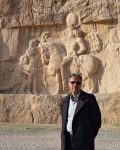| نویسندگان | Mohsen Javeri, Milad Baghsheykhi |
|---|---|
| نشریه | پژوهشهای باستانشناسی ایران |
| نوع مقاله | Full Paper |
| تاریخ انتشار | 1399/12/01 |
| رتبه نشریه | علمی - پژوهشی |
| نوع نشریه | چاپی |
| کشور محل چاپ | ایران |
| نمایه نشریه | ISC |
چکیده مقاله
Religious monuments from ancient period have played an important role in the formation of spatial structure of cities and villages. Archaeological excavations and available historical evidence show that religious sites in historical periods, especially the Sassanid period, have been one of the centers of people for religious ceremonies. One of the important findings of archeological excavations in Isfahan province is a religious building called Vigol fire temple, which was found in excavations of M.Javari in 2010, in 10 kilometers southeast of Aran and Bidgol cities. The materials of this building are unlike with other buildings of its age and has cross-shaped and cruciform plan. In middle of the Vigol fire temple, a fire base consisting of two square platforms and a gypsum columnar stem with spoon-shaped grooves is made of gypsum and rubble. In this regard, the present article has been discussed and analyzed with the aim of recognizing and comparing the architectural aspects of Vigol fire temple with some fire temples in different regions. Therefore, the present study is based on the purpose of basic research and based on the nature and method, historical and analytical research; The required information has been collected through two methods of documentary and field studies and is trying to answer the leading questions: 1. Is it possible to prove its use as a fire temple based on the evidence left from the architecture of this building, and what kind of fire in this fire temple was lit according to historical sources? 2. Has the architectural plan of the Vigol fire temple followed a specific pattern? The results showed that the analysis and comparison of the architectural style of Vigol fire temple with other contemporary Sassanid examples shows the similarities of this work such as architecture or fire base in its construction has used a pattern similar to Sassanid examples and with the presence of neighboring architectural remains, including the twirling Corridor, can be considered the use of a fire temple for it. Also, due to the degree of fire in this period, the fire that was worshiped in this place was probably of the local fire type (Âdorân).
